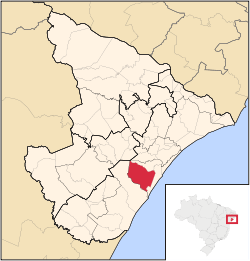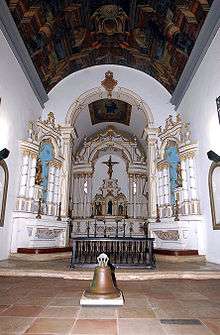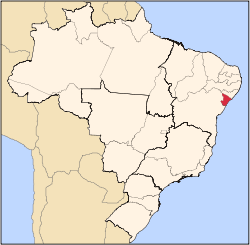São Cristóvão
São Cristóvão (Portuguese pronunciation: [sɐ̃w kɾisˈtɔvɐ̃w], Saint Christopher) is a Brazilian municipality in the Northeastern state of Sergipe. Founded at the mouth of the Vaza-Barris River on January 1, 1590, the municipality is the fourth oldest settlement in Brazil. São Cristóvão is noted for its historic city square, São Francisco Square, and numerous early colonial-period buildings. The 3 hectares (7.4 acres) site was designated a UNESCO World Heritage Site in 2010.[1][2][3][4][5]
São Cristóvão | |
|---|---|
Bairro | |
| Bairro de São Cristóvão | |
_(6).jpg) São Francisco Square, São Cristóvão | |
 Flag  Seal | |
 Location of São Cristóvão in the State of Sergipe | |
 São Cristóvão Location in Brazil | |
| Coordinates: 11°00′54″S 37°12′21″W | |
| Country | Brazil |
| Region | Northeast Region |
| State | |
| Founded | January 1, 1590 |
| Government | |
| • Mayor | Rivanda Batalha |
| Area | |
| • Total | 436.863 km2 (168.674 sq mi) |
| Elevation | 47 m (154 ft) |
| Population (2014 (est.)) | |
| • Total | 85,814 |
| • Density | 196.43/km2 (508.8/sq mi) |
| Time zone | UTC-3 |
| Postal Code | 49100 |
| Official name | São Francisco Square in the Town of São Cristóvão |
| Type | Cultural |
| Criteria | iii, vi |
| Designated | 2010 (34th session) |
| Reference no. | 1272 |
| State Party | Brazil |
| Region | Latin America and the Caribbean |
National Historic Heritage of Brazil | |
| Designated | 1967 |
| Reference no. | 785 |
São Cristóvão covers 437 square kilometres (169 sq mi), making it the third largest settlement in the state of Sergipe behind Aracaju and Nossa Senhora do Socorro.[4] Its population is 85,814 (est. 2014) and has a population density of 196.43 per km2 (508.8/sq mi). São Cristóvão is home to the Federal University of Sergipe, which was established in 1968.[6]
History

São Cristóvão was established by the Portuguese (in a time when Portugal, Spain and the Naples kingdoms were under the rule of Philip II of Spain) as one of the first colonization attempts in Sergipe, which makes the city the fourth oldest one in Brazil. In 1590 the Portuguese sent Cristóvão de Barros to both subjugate the region to colonial rule and establish a safe trading port between Salvador and Pernambuco. De Barros quickly and violently defeated the local population, which consisted of people of mixed Tupinambá and French heritage who maintained a trade in Brazilwood. As a symbol of his victory De Barros founded a small village named for his patron saint, Saint Christopher.[7]
The development of the town followed the Portuguese urban model, that is, in two plans: the higher town, where the headquarters of the civil and religious powers are; and lower town, with the harbour, the factories, and the low income population.[8] The economy of São Cristóvão initially depended on the establishment of cattle herds for meat, milk, and leather. The settlement was completely destroyed by the Dutch in 1637. Tobacco and sugarcane plantations were established in the 17th century, and remained into the modern period.[7] São Cristóvão was the state capital until 1855, when the provincial president Inácio Joaquim Barbosa moved the capital to Aracaju.
In 1967, the city was designated a national monument to preserve its colonial architecture, and it is now home to ten national heritage sites of Brazil.[4] Among the important sacred buildings are the Church and Convent of Santa Cruz (also known as the Church and Convent of São Francisco, which date from 1693), the Misericórdia Hospital and Church (Santa Casa de Misericordia, the 17th-century Sisters of Mercy hospital), the Chapel of the Immaculate Conception of Mary (1751), the Parish Church of Our Lady of Victory (1608) and several other important churches from the 18th century, including the Church of Our Lady of the Rosary of Black Men, the Church of Our Lady of Protection, and the Monastery of São Bento. Ten national or state heritage sites are located in or near the city center; two, the Chapel of Our Lady of the Conception of Engenho Poxim and the Church of Our Lady of Nazareth of Engenho Itaperoá, are abandoned and on sugarcane plantations far from the city center.[9][8]
The religious sites of São Cristóvão remain an important center of Roman Catholic pilgrimage in Brazil. The Museum of Sacred Art of the Church and Convent of São Francisco is considered the third most important in Brazil.[1]
São Francisco Square
São Francisco Square (Praça São Francisco) is an open space surrounded by colonial-period buildings such as the São Francisco Church and convent, the Church and Santa Casa da Misericórdia, the Provincial Palace and other buildings from later periods. The complex is a well-preserved example of typical Franciscan architecture of north-eastern Brazil. On August 1, 2010 the site, which covers 3 hectares (7.4 acres), was selected as a World Heritage Site by UNESCO. It is managed by a regional office of the National Institute of Historic and Artistic Heritage (IPHAN) and the municipal government.[5]
Historic structures
Churches
- Church and Convent of Santa Cruz, or Convent of Saint Francis and the Church of the Good Jesus of Glory, now the Sacred Art Museum (Portuguese: Igreja e Convento de Santa Cruz)
- Misericórdia Hospital and Church (Portuguese: Igreja e Santa Casa da Misericórdia)
- Church of Our Lady of the Rosary of Black Men (Portuguese: Igreja de Nossa Senhora do Rosário dos Homens Pretos
- Church of Our Lady of Protection of the Mulattoes (Portuguese: Igreja de Nossa Senhora do Amparo)
- Church and Convent of Mount Carmel (Portuguese: Igreja e Convento do Carmo)
- Church of the Third Order of Mount Carmel (Portuguese: Igreja da Ordem Terceira do Carmo)
- Parish Church of Our Lady of Victory (Portuguese: Igreja Matriz de Nossa Senhora da Vitória)
Residences
- Sobrado at Rua Castro Alves, 2 (Portuguese: Sobrado à Rua Castro Alves, 2)
- Sobrado at Rua da Matriz (Portuguese: Sobrado à Rua da Matriz)
- Sobrado at Rua das Flores (Portuguese: Sobrado à Rua das Flores)
Rural chapels
- Chapel of Our Lady of the Conception of Engenho Poxim (Portuguese: Capela de Nossa Senhora da Conceição do Engenho Poxim)
- Church of Our Lady of Nazareth of Engenho Itaperoá (Portuguese: Igreja de Nossa Senhora de Nazaré do Antigo Engenho Itaperoá)
Economy
The city is a shipping port, and its main industries are sugar milling and distilling.[2]
References
- Aragão, Ivan Rêgo; Ruiz de Macedo, Janete (2011). "São Cristóvão e divina pastora: locus do turismo religioso em Sergipe-Brasil". Revista Iberoamericana de Turismo – RITUR (in Portuguese). Universidade Federal de Alagoas. 1 (1): 34–46.
- "São Cristóvão". Encyclopædia Britannica. Encyclopædia Britannica Inc. 2015. Retrieved 2015-01-24.
- "Historiador lamenta insegurança que compromete turismo em São Cristóvão". Globo.com (in Portuguese). Rio de Janeiro, RJ, Brazil: Globo Comunicação e Participações S.A. 1 Jan 2015. Retrieved 24 Jan 2015.
- "São Cristóvão" (in Portuguese). Brasilia, Brazil: IBGE. 2015. Retrieved 2015-01-24.
- "São Francisco Square in the Town of São Cristóvão". UNESCO. Retrieved 1 January 2015.
- "Universidade Federal de Sergipe (UFS)". São Cristóvão/SE: Universidade Federal de Sergipe. 2015. Retrieved 2015-01-24.
- Presser, Margaret (2006). Pequeña enciclopédia para descobrir o Brasil. Rio de Janeiro: Editora Senac Rio. pp. 318–321. ISBN 8587864742.
- "São Cristóvão (SE)" (in Portuguese). Brasilia, Brazil: IPHAN. 2015. Retrieved 2015-01-24.
- "Engenho Poxim: capela de Nossa Senhora da Conceição (São Cristovão, SE)" (in Portuguese). Brasília: Instituto do Patrimônio Histórico e Artístico Nacional. Retrieved 2017-04-06.
External Links
| Wikimedia Commons has media related to São Cristóvão (Sergipe). |
